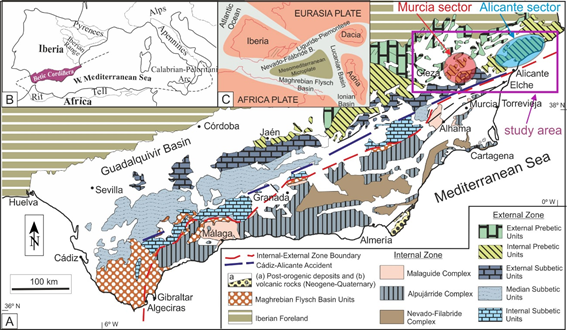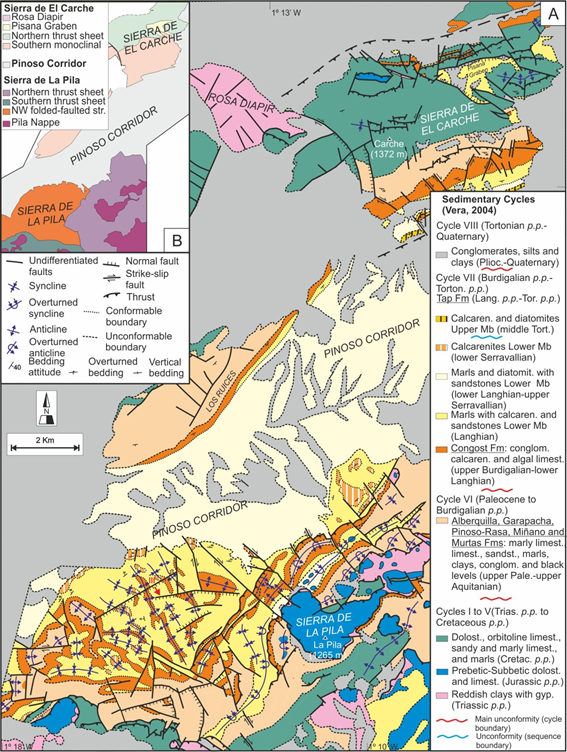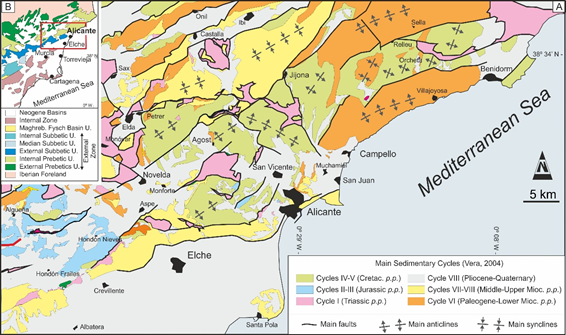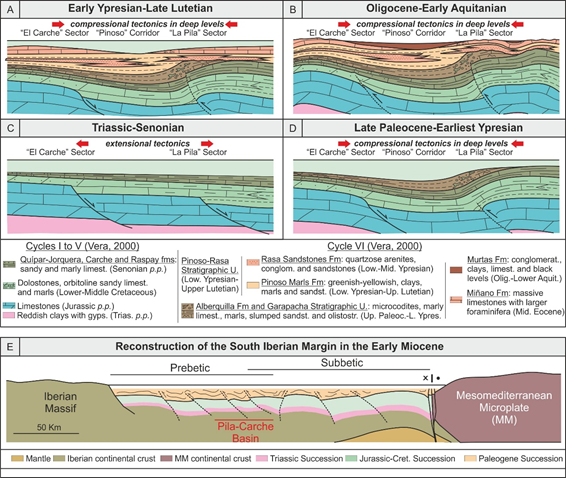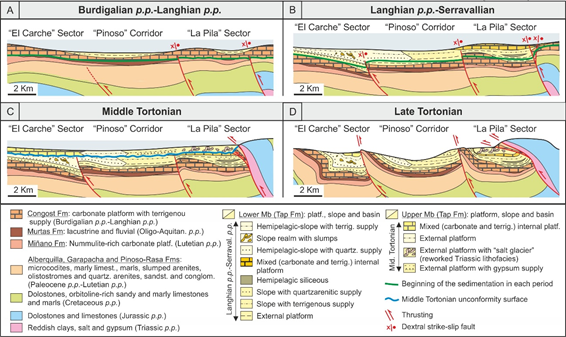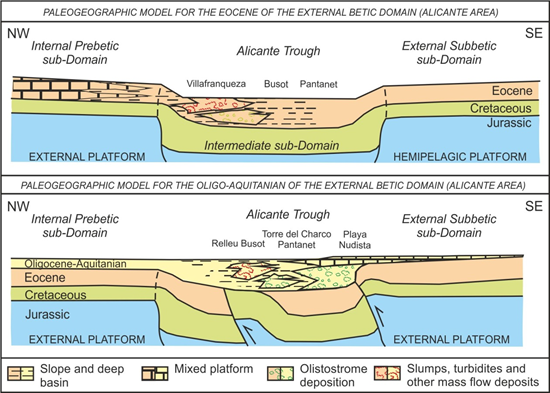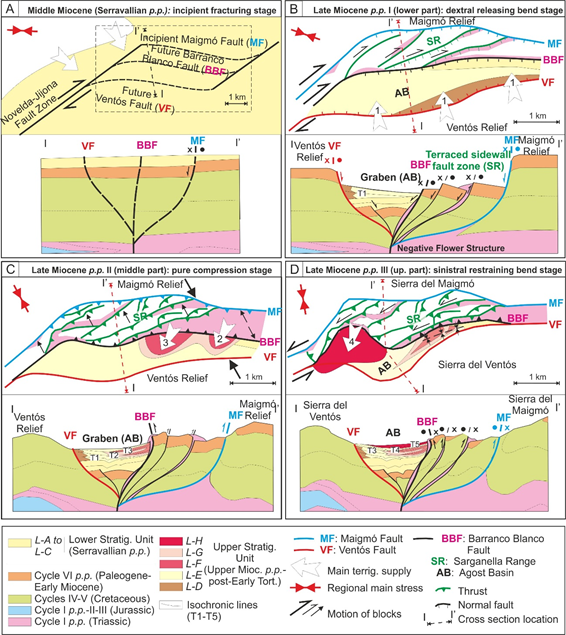Four main unconformities (1-4) were recognized in the sedimentary record of the Cenozoic basins of the eastern External Betic Zone. More in detail, they are located at different stratigraphic levels as follows: (1) Cretaceous-Paleogene boundary even if this unconformity was also recorded at the early Paleocene (Murcia sector) and early Eocene (Alicante sector); (2) Eocene-Oligocene boundary and quite synchronous in the whole considered area; (3) early Burdigalian, and quite synchronous (recognized in the Murcia sector); (4) middle Tortonian (recognized in Murcia and Alicante sectors). These unconformities correspond to stratigraphic gaps of different temporal extensions with different meanings, which allowed recognizing minor sedimentary cycles in the Paleocene-Miocene time span. The Cenozoic marine sedimentation started over the oldest unconformity (i.e. the principal one), above the Mesozoic marine deposits. Paleocene-Eocene sedimentation shows numerous tectofacies (such as: turbidites, slumps, olistostromes, mega-olistostromes and pillow-beds) interpreted as related to an early, blind and deep-seated tectonic activity, acting in the more internal subdomains of the External Betic Zone as a result of the geodynamic processes related to the evolution of the westernmost branch of the Tethys. The second unconformity resulted from a Oligocene to Aquitanian sedimentary evolution in the Murcia Sector from marine realms to continental environments. This last time interval is characterized as the previous one by a gentle tectonic activity. On the other hand, the Miocene sedimentation was totally controlled by the development of superficial thrusts and/or bend zones of strike-slip faults both related to the regional geodynamic evolutionary framework linked to the Mediterranean opening. These bends of strike-slip faults created subsidence areas (pull-apart basin-type) and affected the sedimentation lying above the third unconformity. By contrast, the subsidence areas were bounded by structural highs affected by thrusts and folds. After the third unconformity, the Burdigalian-Serravallian sedimentation occurred mainly in shallow- to deep-water marine environments (Tap Fm). During the late Miocene, after the fourth unconformity, the activation of the bend zones of strike-slip faults caused a shallow marine environment sedimentation in the Murcia sector and a continental (lacustrine and fluvial) deposition in the Alicante sector represented, the latter resulting in alluvial fan deposits. Furthermore, the location of these fans changed over time according to the activation of faults responsible for the tectonic rising of Triassic salt deposits, which fed the fan themselves.
- Eastern External Betic Zone
- Cenozoic basins
- strike-slip tectonics
- Tectono-sedimentary evolution
1. Introduction
The area is located in the Murcia and Alicante provinces of the SE Spain (Figure 1A), which belong to the eastern External Betic Zone (EBZ). This cordillera is included in the Alpine chains of the western Mediterranean (Figure 1B), resulting from the continental collision of the Mesomediterranean Microplate (MM) (Guerrera et al. [1]) at first with the Iberia-Europe Plate (Cretaceous-Paleogene: Eo-Alpine phase), and subsequently, (Miocene: Neo-Alpine or Maghrebian phase) with the Africa Plate and due to the ocean closures driven by oppositely oriented subductions [1][2][3][4][5][6][1–6]. These processes affected the western branches of the Tethys (Figure 1C), generating Mesozoic to Tertiary successions related to several tectono-sedimentary domains [7]. The development of a rifting affecting the South Iberian Margin generated basins with alpine-like platforms (extended and wide, and structured in horsts and grabens), characterized by marine domains which are deeper from north to south, forming the Prebetic (to the north) and the Subbetic (to the south) of the EBZ [7][8][9][7–9].
The deposition in the Cenozoic basins followed the tectonic inversion (from extension to compression) occurring at the latest Cretaceous, being usually marked by a generalized unconformity [10]. Sometimes, Paleogenic deposits show paleoenvironmental conditions similar to those of the Mesozoic successions, and sedimentation is a continuation of the former. In these cases, shallow water sediments deposited above the inherited structural highs (horsts), passing laterally to deep realms (grabens). In particular, the deep deposits are characterized by turbidite deposits with olisthostrome and slumps on the slope and more deep areas [11][12][13][14][15][11–15].
Vera [16][17][16,17] provided a general framework of the Mesozoic to Cenozoic sedimentation of the EBZ, dividing the stratigraphic record into eight main sedimentary cycles. Recently, detailed multidisciplinary studies carried out in the eastern EBZ suggested the following remarks about the tectono-sedimentary evolution of the area: (1) the definition of a new and earlier Paleogene deformation stage [15][18][19][15,18,19], (2) the Paleogene deformation was related to the Internal Betic Zone (IBZ) tectonics paleo-geographically close to the IBZ, as proposed by Guerrera et al. [15], Guerrera and Martín-Martín [18] and Guerrera et al. [19], (3) the importance of strike-slip Miocene fault systems [20][21][20,21] and (4) the influence of salt tectonics also during the Miocene evolution [22–24]. Therefore, the knowledge of these Cenozoic basins has been considerably improved because these papers show their tectono-sedimentary evolution.
In short, the main aim of this paper is to present a review of the evolution of the Cenozoic basins in the eastern EBZ, considering previous reconstructions and the broad recent literature. In concrete, the considered area corresponds to the Pila-Carche sector (Figure 2) and the Alicante sector (Figure 3) in the Murcia and Alicante provinces, respectively. The review also aims to propose the considered studied sector as a key area for studies addressed to the tectono-sedimentary evolution of Cenozoic basins in the western Mediterranean chains.
Figure 1. The Betic Cordillera (after Reference [19]; modified). (A) Geological map of the Betic Cordillera with the location of Cenozoic Basins of the eastern External Betic Zone (EBZ) (study area), the Murcia (Figure 2) and Alicante (Figure 3) sectors. (B) Geographic location of the Betic Cordillera in the context of the western Mediterranean alpine chains. (C) Paleogeographic sketch of the western Mediterranean area during the Cretaceous.
Figure 2. Geological maps of the eastern EBZ in the Murcia sector (after Reference [20]; modified). (A) Detailed geological map of the Pila-Carche area. (B) Structural sketch map of the Pila-Carche area.
Figure 3. Geological maps of the eastern EBZ in the Alicante sector (after Reference [21]; modified). (A) Detailed geological map of the Alicante sector. (B) Structural sketch map of the Alicante sector.
2. Background History
The regional geological studies in the eastern Betics started at the end of the XIX century (e.g., the authors of References [22][23][24][25][26][25–29] pointed out that this area belonged to the Prebetic-Subbetic transition of the eastern EBZ). Several geomorphological alignments (mountains), bounded by Cenozoic basins, were signaled. These reliefs correspond with tectonic elements related to north-vergent fold-thrust nappes, as indicated by Rodríguez-Estrella [27][28][30,31]. Other authors [29][30][31][32][33][34][35][36][32–39] have also indicated that the area was affected by several Miocene-Quaternary strike-slip fault systems. The previous authors have also pointed the occurrence of salt tectonics processes associated to the strike-slip faulting.
According to previous works [26][27][28][29–31], during the Jurassic, the Prebetic (external-most domain) constituted a distal shallow carbonate platform, while the Subbetic (internal-most domain) was represented by a subsiding area, with deposition of deep-water pelagic marls. Later, during the Cretaceous, deep realms were widespread both in Prebetic and Subbetic domains. The Cenozoic shows a greater variety of sediments, which are marked by detritic supplies alternating with deep- or shallow-water deposits [16][26][37][16,29,40]. Many Neogene deformation phases were proposed [30][33]: thrusting (Early Miocene), normal faulting (Middle Miocene) and development of strike-slip faulting (Late Miocene). Furthermore, studies concerning the Eocene platform areas were carried out by Geel [12][13][12,13] and Geel et al. [14]. Also, analyses on deeper marine sediments were developed by Roep and Everts [11].
More recently, specific papers concerning the tectono-sedimentary evolution of Cenozoic basins in the eastern EBZ have been published. Guerrera et al. [15] and Guerrera and Martín-Martín [18] propose the Paleogene evolution of the Cenozoic Alicante Trough Basin characterized by a narrow shaped sedimentary basin with tectonically active margins located to the NNW in the Jijona-Elda area (mainly functioning during the Eocene) and to the SSE in a position now under the Mediterranean sea (during the Oligocene), respectively. The infilling of the Alicante Trough, which is subdivided by two unconformities into two depositional sequences (Eocene p.p. and Oligocene p.p. in age, respectively), pointed out “catastrophic” syn-sedimentary tectonic processes including slumps, mega-olisthostromes, “pillow-beds” and turbidite deposits.
Analyzing the Paleogene evolution of the Pila and Carche basins (EBZ, north of the Murcia province), Guerrera et al. [19] recognized several depositional sequences (defined Middle–Upper Maastrichtian, Upper Paleocene–Middle Eocene, and Oligocene–Lower Aquitanian in age) with associated slumps and olisthostromes that can justify a syn-sedimentary tectonic activity. Martín-Martín et al. [20] studied the Miocene evolution of the same area, and by means of a better chronostratigraphic resolution, proposed a more advanced reconstruction of the stratigraphic architecture. These studies detected the presence of two main depositional sequences (Upper Burdigalian–Upper Serravallian and Upper–Middle Tortonian in age) in the Pila and Carche Cenozoic basins. According to the lateral-vertical distribution of the lithofacies and the thicknesses of the stratigraphic formations, the migration of the foredeep has been better specified, highlighting a complex tectono-sedimentary evolution. The same authors (Martín-Martín et al. [21][38][21,22]) studying the Cenozoic basins in the Alicante province recognized that the Miocene-Quaternary shallow marine and continental infilling has been controlled by the evolution of several curvilinear faults involving salt tectonics. These authors also specified that the occurrence of Triassic shales and evaporites played a fundamental role in the tectonic evolution of the study area since the salt material flowed along faults, generating salt walls in root zones and salt push-up structures at the surface.
In conclusion, the extensive information from the numerous previous studies, if taken as a whole, and analyzed and correlated, allow for synthesizing the tectono-sedimentary evolution of the Cenozoic basins of the eastern EBZ, evidencing its character of a key area.
3. Tectono-Sedimentary Evolution of the Cenozoic Basins of the Eastern External Betic Zone
3.1. The Murcia Sector (Cenozoic Pila-Carche Basin)
In the Cenozoic successions of these basins, the recognition of unconformity boundaries allows for subdividing the sedimentary record into four tectono-stratigraphic successions characterized by a different temporal extension: (i) Upper Paleocene–Upper Eocene, (ii) Oligocene–Lower Aquitanian, (iii) Upper Burdigalian–Upper Serravallian and (iv) Upper Miocene p.p. (Figures 8 and 9). The whole stratigraphic record represents a geological cycle indicative of a regressive general trend and starting with a regressive phase (from hemipelagic to continental environments), then continuing with a second transgressive-regressive phase during the Middle to Late Miocene (Figures 8 and 9).
- The Upper Paleocene–Upper Eocene tectono-stratigraphic unit (Figure 8) shows, after an initial transgression, a progressive shallowing upward marine trend. During the Paleocene to Early Eocene, the sedimentation (Alberquilla, Garapacha, Pinoso-Rasa fms) reflects a slope environment that evolved during the Middle–Late Eocene to a carbonate platform environment (Miñano Fm). A main unconformity boundary in the Early Oligocene marks a stratigraphic gap also evidenced by a widespread paleokarst, pointing out an emersion of the basin.
- During the Oligocene (Murtas Fm), a transgression occurred with the development of marshy and beach lithofacies (Figure 8), followed by a new regressive depositional trend indicated by continental lacustrine and fluvial deposits during most of the Oligocene up to the Aquitanian.
Thickness and areal distribution of lithofacies of this tectono-stratigraphic unit indicate a subsidence area located between other uplifting ones (Figure 8). During the Paleogene-Aquitanian, the tectonic framework was characterized by a blind tectonics for the reactivation of old faults and the presence of Jurassic-Cretaceous blocks affected by folding in deep levels. These tectonics caused differential vertical movements generating areas affected by subsidence and other uplifting areas. The thick marine and transitional environment sedimentation is usually followed by continental deposits formed in a condition of relative subsidence. Instead, the uplifted areas are highlighted by paleokarst surfaces and a thin continental cover.
Figure 8. Paleogene tectono-sedimentary evolution of the Pila-Carche Cenozoic Basin (Murcia sector) of the eastern EBZ (after Reference [19]; modified). (A) Paleogeographic sketch showing a cross-section referable to the Late Ypressian-Early Lutetian interval, (B) paleogeographic sketch showing a cross-section referable to the Oligocene-Early Aquitanian interval, (C) paleogeographic sketch showing a cross-section referable to the Triassic-Senonian interval, (D) paleogeographic sketch showing a cross-section referable to the Late Paleocene-Earliest Ypressian interval, (E) paleogeographic sketch showing a cross-section referable to the Early Miocene.
- The Upper Burdigalian–Upper Serravallian tectono-stratigraphic unit (Pila-Carche Basin, Figure 9) shows a transgressive-regressive trend. The transgression, which began in the Late Burdigalian, reaching the Late Langhian (Congost Fm), results younger in some sectors of the basins because of the onlap arrangement of transgressive deposits on the previous deformed succession. The evolution begins with an internal platform environment sedimentation, while during the Early Langhian, a mixed carbonate and terrigenous supply indicates an external platform to upper slope environment.
Later, the Burdigalian upper Langhian Congost Fm passes laterally and upwards to the Lower member of the Tap Fm (Figure 9), and the presence of clastic deposits suggests a transition platform, slope and basinal environments, with an increase of terrigenous inputs. The Lower member of the Tap Fm is characterized by deeper marine lithofacies, showing a quartzarenitic supply. The deepest environment is also marked by Upper Langhian p.p. silexites. In turn, the presence of slumps implies the presence of a slope. Both silexites and slumps are considered to indicate a deepening phase occurring during Miocene. Compression, folding and lithostatic load related to the overlapping nappes resulted in the development of subsidence or uplifting areas, as shown by the increasing thicknesses of the Langhian-Serravallian successions.
The fourth main unconformity is probably related to a new emersion at the beginning of the compressional thin-skinned tectonics and recorded by a marked stratigraphic gap (early Tortonian).
- The Middle Tortonian tectono-stratigraphic unit (Pila-Carche Basin) shows a new transgressive-regressive cycle (Upper member of the Tap Fm). According to the sedimentological data, the depositional environment of this unit ranges between internal mixed (carbonate and siliciclastic) platform to external platform. Reworked Triassic clays and gypsum (olisthostromes) indicate a deposition on a slope realm. In this phase, the faulting reached the surface, generating thrusts and strike-slip faults and related features. The blocks between the faults were also folded and sometimes developed to form nappes.
Figure 9. Neogene tectono-sedimentary evolution of the Cenozoic Pila-Carche Basin (Murcia sector) in the eastern EBZ (after Reference [20]; modified). (A) Paleogeographic sketch showing a cross-section referable to the Burdigalian-Langhian p.p. interval, (B) paleogeographic sketch showing a cross-section referable to the Langhian p.p.-Serravallian interval, (C) paleogeographic sketch showing a cross-section referable to the Middle Tortonian, (D) paleogeographic sketch showing a cross-section referable to the Late Tortonian.
3.2. Alicante Sector (Cenozoic Alicante Trough and Agost Basin)
The Paleogene deposition of the Alicante Trough shows a clear regressive trend from a slope environment (Eocene) to a shelf environment (Oligocene-Aquitanian), accompanied by an increase of tectofacies upwards. During the Eocene, turbidite arenites and slumps coming from the western–northwestern area and showing a transgressive trend, deposited. Oligocene–Lower Aquitanian slumps, olisthostromes, mega-olisthostromes and pillow-beds (coming from the eastern–southeastern area) are instead arranged to show a regressive-transgressive-regressive trend.
During the Paleogene, the Alicante Trough (Figure 10) is a subsidence area bounded by two northwestern and southeastern margins related to the Prebetic Zone and External Subbetic subdomain, respectively [15].
During the Eocene (Figure 10), the sedimentation of this trough was mainly influenced by the western or northwestern Prebetic margin, by an incipient tectonic instability that gave rise to turbidites associated with hemipelagic deposits, arranged in triplet para-sequences. This Eocene sedimentation is correlated with the Pila-Rasa Fm (Murcia sector). In contrast, during the Oligocene and up to Early Aquitanian (Figure 10), the basin was mainly influenced by the opposite margin, located southeastwards (Subbetic substratum). In this case, the sedimentation is related to marine realms, differently with respect to the continental environments of the Murtas Fm (Murcia sector). The lithofacies association (marls with slumps, olistostromes, mega-olistostromes and pillow-beds) indicates the dismantling of a platform, also by means of paleocurrents, and the west- or northwestwards-facing of slumps, from which a tectonic activity of the margin is deduced. Pillow-beds, which are structures interpreted as seismites as a result of high-magnitude earthquakes [11], favored the construction of submarine fan systems.
Figure 10. Eocene and Oligo-Aquitanian tectono-sedimentary evolution of the Cenozoic Alicante Trough and neighbor areas (Alicante province) of the eastern EBZ (after Reference [18]; modified). Paleogeographic sketch showing a cross-section referable to the Oligo-Aquitanian interval, in the lower part, and to the Eocene, in the upper part.
During the Miocene, the Congost Fm is not represented but the Tap Fm is recognizable in the Alicante sector. In any case, the Cenozoic basins evolved in a different way in the Alicante region (Agost Basin, Figure 11). In this region, fault bends acted as transtensive dextral strike-slip systems delimiting pull-apart-like basins with shallow marine and continental deposits. The reorientation of the main regional stress caused changes in the kinematics of the strike-slip faults, which evolved as reverse (compressive) faults at first, and as sinistral (transpressive) faults later (Figure 10). During the transtensive phase, the Triassic salt risen from a deep stratigraphic level tended to escape to the surface as salt walls to be eroded and deposited as alluvial fan in the basins. The deposition of the alluvial fans changed its position over time, with these depositional systems being progressively replaced by others according to the displacement of the active faults.
Figure 11. Neogene tectono-sedimentary evolution of the Agost Basin (Alicante province) of the eastern EBZ (after Reference [21]; modified). The main regional stress, motion of blocks, faults’ actuation and main terrigenous supply is represented. (A) paleogeographic sketch map and section of the Serravallian, (B, C, D) paleogeographic sketch maps and sections of the Late Miocene.
4. Conclusions
The Cenozoic basins of the eastern EBZ were located over a Mesozoic sedimentary substratum after the tectonic inversion (from extensional to compressional) occurring at the latest Cretaceous [15,18]. These basins were subsidence areas nourished by located nearby structural heights. Some differences in the sedimentary record observed in these basins can be summarized as follows: (1) The Paleocene deposits are not present in the Alicante sector where they are replaced by a marked unconformity, located at the base of the Eocene; in the Murcia sector, the gravitational slope environment related to the Paleocene deposits are well represented. (2) The deeper Eocene deposits recognized in the Alicante sector (external platform, slope and deep basin environment) are in contrast with the Middle–Upper Eocene shallow-water marine ones (internal platform) of the Murcia sector. (3) The Oligocene-Aquitanian deposits are related to a continental environment and are very reduced in the Murcia sector, while they are well represented in the Alicante sector where they indicate an initial marine external platform environment, which passes to a slope environment.
In both areas, terrigenous supplies have been supplied from the active basinal margins, in the Early Paleogene from the northwestern area and in the Late Paleogene-Aquitanian from the southeastern area. In these successions, turbidites, olistostromes, slumps and pillow-beds have been interpreted as indicative of an early tectonic activity (Guerrera and Martín-Martín [18]). A progressive eastward reduction of subdomain areas in the EBZ has been interpreted as due to the action of the Cadiz-Alicante strike-slip fault zone [32][35] from the Lower–Middle Miocene onwards. Nevertheless, according to Guerrera et al. [15] and Guerrera and Martín-Martín [18], this progressive sub-domain’s reduction should be older and related to the transform fault responsible for the Internal–External Zone Boundary tectonic contact (References [1][5][6][1,5,6], and references therein), which is related to the collision between the Mesomediterranean Microplate (MM) and the EBZ (Figure 12A). In our opinion, the early and local tectonic activity recorded in the eastern EBZ is probably due to the paleogeographic position of the eastern EBZ located very close to the IBZ during this period. This activity could explain the dismantling of the External Subbetics during the Oligocene–Early Aquitanian, since this sub-Domain was the most internal Subbetic one, located close to the MM and separated with respect to the latter by the mentioned active transform fault.
Figure 12. General geodynamic framework of the eastern EBZ in the context of the western peri-Mediterranean alpine chains. (A) geodynamic interpretation of the western Tethys during the Eocene (after Reference [19], modified), (B) geodynamic framework of the central-western Mediterranean area during the Miocene (modified from Reference [20]), (C) synthetic columns of the Cenozoic Bains in the Murcia and Alicante sectors of the eastern EBZ (after Guerrera et al. [19], modified)
The Miocene deposits (Congost and Tap fms) are absent in the Alicante Trough but the Lower and Upper Members of the Tap Fm are recognizable in the Agost Basin [21][38][21,22]. During the Middle Miocene, the EBZ was affected by a net of strike-slip fault-related bend zones experiencing kinematic changes over time from a transtensive dextral to a transpressive sinistral one, according to the main regional stress. Subsidence areas delimited by fault traces and folded structural highs were also developed and the fault traces, usually present as Triassic salty materials, were injected. During the Late Miocene, this salty material was eroded and redeposited during the construction of the alluvial fans, which occurs in relation to and under the control of the strike-slip fault zones movement. This tectonic activity, and related bends of strike-slip faults, should be connected with the regional framework characterized by the Mediterranean opening (Figure 12B) and the westward migration of the Internal Betic Zone (the previous MM) by means of a transform fault.
In the sedimentary record of the Cenozoic basins (eastern EBZ), the following four main unconformities are recognizable (Figure 12C): (1) at the Cretaceous-Paleogene boundary (angular unconformity), recorded at the K/Paleocene boundary (with a related Danian gap) in the Murcia sector, and at the K/Eocene boundary (with a gap covering the entire Paleocene) in the Alicante sector, (2) at the Eocene-Oligocene boundary (with an angular unconformity, a paleokarst surface and a stratigraphic gap corresponding to the Bartonian-Priabonian and the Rupelian p.p.). This unconformity is quite synchronous in the whole area. (3) In the Burdigalian (with an angular unconformity and a stratigraphic gap corresponding to the Late Aquitanian–Early Burdigalian), this unconformity is also quite synchronous, and (4) in the Late Miocene (Lower/Middle Tortonian) and recorded in the whole eastern EBZ as a paraconformity with a gap affecting the Serravallian p.p. and the Early Tortonian.
The detected unconformities delimitate the following depositional sequences: (1) the Paleocene p.p.–Late Eocene p.p., showing a transgressive-regressive trend with a maximum flooding surface at the Paleocene/Eocene boundary, (2) the Oligocene p.p.–Aquitanian p.p., showing a transgressive-regressive trend but with a too-reduced sedimentation to deduce anything more, (3) the Burdigalian p.p.–Serravallian p.p., showing a transgressive-regressive trend with a maximum flooding surface at the latest Langhian and (4) the Middle Tortonian p.p., showing a transgressive-regressive trend but with a too-reduced sedimentation to deduce anything more.
The comparison among unconformities and trend evolution of the depositional sequences with the standard eustatic curves (Figures 4 and 5) allow some important constraints: (1) the Paleocene transgression corresponds with an eustatic lowering (Figure 4) because the evolution should be tectonically controlled, (2) the Eocene/Oligocene boundary unconformity is well correlated with an eustatic lowering (Figure 4) and the Oligocene-Aquitanian depositional sequence can be explained as caused by an eustatic phenomenon, (3) the Langhian transgressive trend corresponds with several transgressive-regressive variations in the eustatic curve (Figure 5), so that it should be controlled by tectonics and (4) the transgressive-regressive trend of the Middle Tortonian p.p. depositional sequence corresponds with a stand in the eustatic curve (Figure 5) that should be explained by tectonics.
In short, depositional sequences and unconformities partially match with the sedimentary cycles and cycle boundaries of the EBZ proposed by Vera [16][17][16,17]. So, the K/T unconformity marks the beginning of the Cycle VI and the intra-Burdigalian boundary unconformity indicates the beginning of the Cycle VII. Nevertheless, two new unconformities have been described before dividing in turn the Cycles VI (at the Eocene/Oligocene boundary) and VII (Lower/Middle Tortonian). These two new unconformities add more detail to the reconstruction of the stratigraphic architecture of the Cenozoic basins of the EBZ.
Cenozoic basins started to develop over the Mesozoic basement after the first main unconformity. The Paleocene-Eocene slope and deep basin deposition is characterized by numerous sedimentary inputs consisting of turbidites, slumps, olisthostromes, mega-olistostromes and by pillow-beds, which point out early blind (deep-seated) tectonics acting mainly in the most internal subdomains of the EBZ and related to the geodynamic evolution of the western-most Tethys. The second unconformity leads to a shallowing during the Oligocene to Aquitanian marked by a shallow-water marine sedimentation in the Alicante sector, and even a continental deposition in the Murcia sector. In this latter period, tectonic conditions were similar to those of the previous period. Differently, the Miocene sedimentation was controlled by the development of superficial thrusts and/or bends on strike-slip faults, with all these structures being related to the geodynamic evolution linked to the Mediterranean opening. Thrusts and bends on strike-slip faults created subsidence areas (pull-apart basin-like), which created accommodation for successive sediments that deposited after the above-mentioned unconformity (3). Subsiding areas were bounded by structural highs affected by thrusts and folds. So, after the third unconformity, the sedimentation of these latest basins was mainly made by marine shallow-water to deep sediments (Lower member of Tap Fm) from Burdigalian to Serravallian. After the unconformity (4), during the Late Miocene (Tortonian), the bend development along strike-slip faults caused salt tectonic processes and the presence of shallow-water marine basins characterized by the Upper member of the Tap Fm (Murcia sector), or by continental (lacustrine and fluvial) deposition with alluvial fans in the Alicante sector. These alluvial fans were changing their position over time following the fault development, being mainly fed from fault-controlled rising of the Triassic material.

